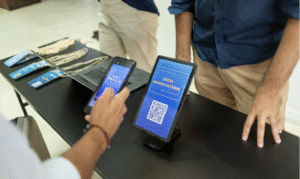
Imagine this: A student misses a critical scholarship deadline, not because they weren’t interested, but because they never saw the email buried in their inbox. Another signs up for a campus tour but doesn’t receive a reminder, and no one follows up. Meanwhile, your team is juggling spreadsheets, toggling between platforms, and left wondering: Are we actually reaching the students who need us most?
If this sounds familiar, your student journey event planning might need a closer look. These moments aren’t just operational hiccups. They’re missed opportunities to connect, engage, and support students at the moments that matter most.
Why Student Engagement Matters at Every Stage

Student engagement isn’t just a checkbox or a feel-good metric. It’s the heartbeat of a thriving institution. When students feel seen, supported, and connected, they’re more likely to show up, persist through challenges, and become lifelong advocates for your campus community.
Whether it’s a welcome event that eases first-year nerves or a career panel that sparks a new ambition, these moments shape more than attendance lists—they shape lives.
That’s why tracking engagement directly in Salesforce isn’t just helpful. It’s transformative. With a clear view of who’s participating and how, institutions can:
- Identify which students are actively participating in programs and events
- Tailor follow-up based on engagement levels and interests
- Proactively support students who aren’t engaging as expected
- Spot trends across cohorts, departments, or event types
This insight empowers teams to plan more relevant events, improve outreach, and create meaningful moments throughout the student journey.
The Problem: Siloed Systems and Disconnected Teams
In higher education, events shape the student journey from that first impression to lasting alumni relationships. But in many institutions, event planning still happens in silos. Different departments use separate tools, workflows, and data systems, making it difficult to understand event impact or deliver a cohesive student experience.
This fragmentation creates real problems:
- Inconsistent data spread across systems
- Duplicated effort across departments
- Missed opportunities to engage students, constituents, and alumni at key moments
Left unchecked, these gaps can lead to more than missed emails. They can result in disengaged students, lower retention, and lost contributions from under-attended events or unengaged alumni. The longer these systems stay disconnected, the more momentum and relationships are lost.
To improve outcomes, institutions need to rethink how event planning connects with the student journey inside the CRM they already use: Salesforce.
Connecting Event Planning With the Student Journey
By aligning event planning with the full lifecycle, from prospective student to engaged alumnus, institutions can:
- Map key touchpoints across enrollment, academics, student life, and alumni engagement
- Tailor events to specific stages: yield events for admits, onboarding for new students, career panels for juniors, reunions for alumni
- Use data to guide programming and outreach across departments, including advancement
This comprehensive view strengthens relationships across the full student and alumni lifecycle, improving student engagement and institutional impact.
The Role of Salesforce-Native Tools
That’s where Salesforce-native tools come in. By managing event planning directly in Salesforce, higher education teams can:
- Automate registration, reminders, and attendance tracking, freeing staff from manual work
- Capture engagement data and connect it to Education Cloud records so every touchpoint informs the next
- Analyze participation trends to guide future planning, improving event effectiveness
- Coordinate across teams using shared views of the student journey, eliminating silos
Tracking event attendance in Salesforce helps teams understand participation trends and guide follow-up efforts. Equally important: knowing which events make the most difference. Need help measuring that impact? See our guide on how to measure higher education event ROI.
This native approach improves efficiency and enables more relevant, timely outreach that supports student engagement and alumni connection.
Real-World Impact of a Unified Strategy on Student Journey Event Planning

Imagine seeing event participation rise, follow-ups happen automatically, and your team finally having time to focus on high-impact work because your data, processes, and goals are finally aligned in one place.
When institutions manage events within Salesforce, that’s exactly what’s possible. The results are clear:
- More personalized engagement, tailored to individual student needs at every stage, from prospective applicants to alumni donors
- Improved retention, as events reinforce community, academic success, and student well-being
- Higher ROI, through better use of staff time and more precise metrics tied to actual outcomes
- Stronger institutional reputation, thanks to consistent experiences that reflect well on your brand
Building a Unified Strategy: What to Do Next
Moving from siloed event management to a unified, Salesforce-native strategy doesn’t happen overnight, but the benefits are worth it. Here’s how to get started:
1. Map the Full Student Journey
Start by identifying key stages across the entire relationship lifecycle. Ask:
- What events support students at each phase?
- How do alumni continue engaging through events after graduation?
- Where are there gaps or duplicated efforts across departments?
This journey map becomes your blueprint for strategic, purpose-driven events.
2. Break Down Silos and Align Teams
Event planning doesn’t belong to one department. It spans admissions, student success, student affairs, academic programs, and advancement. Unifying these efforts requires shared goals, open communication, and alignment on data and processes.
Bring teams together to:
- Define success metrics for events across the lifecycle
- Share data and insights across departments
- Standardize how events are tracked and measured
When everyone operates from the same system and strategy, it’s easier to create meaningful, consistent experiences.
3. Adopt a Salesforce-Native Tool That Works for Higher Ed
Not all event tools are built with higher ed in mind, and very few are native to Salesforce. Look for a platform that supports the full range of higher ed events and integrates seamlessly with Salesforce and Education Cloud.
Choosing the Right Tool for the Job
Need help identifying the best Salesforce-native tool for your institution? Check out our guide, How to Choose the Best Event Technology for Higher Education, built specifically for higher ed event professionals. It walks through key vendor questions, must-have platform features, and how Salesforce-native tools support a connected student journey from prospective student to alum.
Ready to stop juggling tools and start running smarter events?
Schedule a demo and see how Blackthorn works inside Salesforce.



